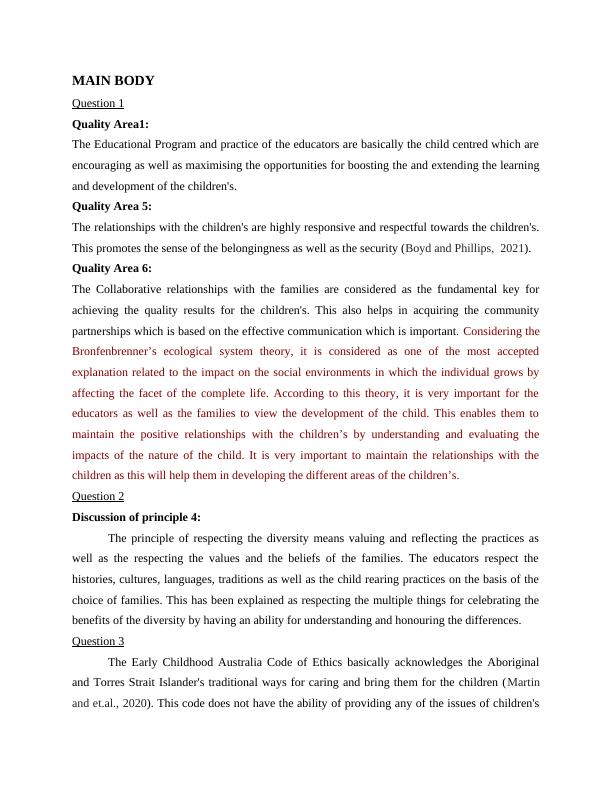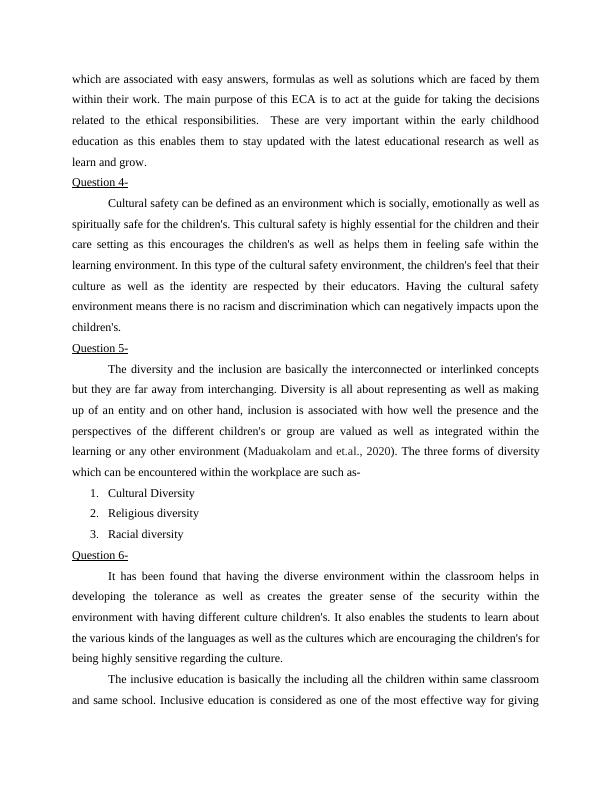Inclusive Education and Cultural Diversity: A Guide for Educators
Added on 2023-06-07
12 Pages3630 Words256 Views
Questions

TABLE OF CONTENT
MAIN BODY...................................................................................................................................3
Question 1....................................................................................................................................3
Question 2....................................................................................................................................3
Question 3....................................................................................................................................3
Question 4-...................................................................................................................................4
Question 5-...................................................................................................................................4
Question 6-...................................................................................................................................4
Question 7-...................................................................................................................................5
Question 8-...................................................................................................................................5
Question 9-...................................................................................................................................5
Question 10-.................................................................................................................................5
Question 11..................................................................................................................................6
Question 12..................................................................................................................................7
Question 13..................................................................................................................................7
Question 14..................................................................................................................................7
Question 15..................................................................................................................................7
Question 16..................................................................................................................................8
Question 17..................................................................................................................................8
Question 18..................................................................................................................................8
Question 19..................................................................................................................................9
Question 20..................................................................................................................................9
Learning activity:.........................................................................................................................9
REFERENCES................................................................................................................................1
MAIN BODY...................................................................................................................................3
Question 1....................................................................................................................................3
Question 2....................................................................................................................................3
Question 3....................................................................................................................................3
Question 4-...................................................................................................................................4
Question 5-...................................................................................................................................4
Question 6-...................................................................................................................................4
Question 7-...................................................................................................................................5
Question 8-...................................................................................................................................5
Question 9-...................................................................................................................................5
Question 10-.................................................................................................................................5
Question 11..................................................................................................................................6
Question 12..................................................................................................................................7
Question 13..................................................................................................................................7
Question 14..................................................................................................................................7
Question 15..................................................................................................................................7
Question 16..................................................................................................................................8
Question 17..................................................................................................................................8
Question 18..................................................................................................................................8
Question 19..................................................................................................................................9
Question 20..................................................................................................................................9
Learning activity:.........................................................................................................................9
REFERENCES................................................................................................................................1

MAIN BODY
Question 1
Quality Area1:
The Educational Program and practice of the educators are basically the child centred which are
encouraging as well as maximising the opportunities for boosting the and extending the learning
and development of the children's.
Quality Area 5:
The relationships with the children's are highly responsive and respectful towards the children's.
This promotes the sense of the belongingness as well as the security (Boyd and Phillips, 2021).
Quality Area 6:
The Collaborative relationships with the families are considered as the fundamental key for
achieving the quality results for the children's. This also helps in acquiring the community
partnerships which is based on the effective communication which is important. Considering the
Bronfenbrenner’s ecological system theory, it is considered as one of the most accepted
explanation related to the impact on the social environments in which the individual grows by
affecting the facet of the complete life. According to this theory, it is very important for the
educators as well as the families to view the development of the child. This enables them to
maintain the positive relationships with the children’s by understanding and evaluating the
impacts of the nature of the child. It is very important to maintain the relationships with the
children as this will help them in developing the different areas of the children’s.
Question 2
Discussion of principle 4:
The principle of respecting the diversity means valuing and reflecting the practices as
well as the respecting the values and the beliefs of the families. The educators respect the
histories, cultures, languages, traditions as well as the child rearing practices on the basis of the
choice of families. This has been explained as respecting the multiple things for celebrating the
benefits of the diversity by having an ability for understanding and honouring the differences.
Question 3
The Early Childhood Australia Code of Ethics basically acknowledges the Aboriginal
and Torres Strait Islander's traditional ways for caring and bring them for the children (Martin
and et.al., 2020). This code does not have the ability of providing any of the issues of children's
Question 1
Quality Area1:
The Educational Program and practice of the educators are basically the child centred which are
encouraging as well as maximising the opportunities for boosting the and extending the learning
and development of the children's.
Quality Area 5:
The relationships with the children's are highly responsive and respectful towards the children's.
This promotes the sense of the belongingness as well as the security (Boyd and Phillips, 2021).
Quality Area 6:
The Collaborative relationships with the families are considered as the fundamental key for
achieving the quality results for the children's. This also helps in acquiring the community
partnerships which is based on the effective communication which is important. Considering the
Bronfenbrenner’s ecological system theory, it is considered as one of the most accepted
explanation related to the impact on the social environments in which the individual grows by
affecting the facet of the complete life. According to this theory, it is very important for the
educators as well as the families to view the development of the child. This enables them to
maintain the positive relationships with the children’s by understanding and evaluating the
impacts of the nature of the child. It is very important to maintain the relationships with the
children as this will help them in developing the different areas of the children’s.
Question 2
Discussion of principle 4:
The principle of respecting the diversity means valuing and reflecting the practices as
well as the respecting the values and the beliefs of the families. The educators respect the
histories, cultures, languages, traditions as well as the child rearing practices on the basis of the
choice of families. This has been explained as respecting the multiple things for celebrating the
benefits of the diversity by having an ability for understanding and honouring the differences.
Question 3
The Early Childhood Australia Code of Ethics basically acknowledges the Aboriginal
and Torres Strait Islander's traditional ways for caring and bring them for the children (Martin
and et.al., 2020). This code does not have the ability of providing any of the issues of children's

which are associated with easy answers, formulas as well as solutions which are faced by them
within their work. The main purpose of this ECA is to act at the guide for taking the decisions
related to the ethical responsibilities. These are very important within the early childhood
education as this enables them to stay updated with the latest educational research as well as
learn and grow.
Question 4-
Cultural safety can be defined as an environment which is socially, emotionally as well as
spiritually safe for the children's. This cultural safety is highly essential for the children and their
care setting as this encourages the children's as well as helps them in feeling safe within the
learning environment. In this type of the cultural safety environment, the children's feel that their
culture as well as the identity are respected by their educators. Having the cultural safety
environment means there is no racism and discrimination which can negatively impacts upon the
children's.
Question 5-
The diversity and the inclusion are basically the interconnected or interlinked concepts
but they are far away from interchanging. Diversity is all about representing as well as making
up of an entity and on other hand, inclusion is associated with how well the presence and the
perspectives of the different children's or group are valued as well as integrated within the
learning or any other environment (Maduakolam and et.al., 2020). The three forms of diversity
which can be encountered within the workplace are such as-
1. Cultural Diversity
2. Religious diversity
3. Racial diversity
Question 6-
It has been found that having the diverse environment within the classroom helps in
developing the tolerance as well as creates the greater sense of the security within the
environment with having different culture children's. It also enables the students to learn about
the various kinds of the languages as well as the cultures which are encouraging the children's for
being highly sensitive regarding the culture.
The inclusive education is basically the including all the children within same classroom
and same school. Inclusive education is considered as one of the most effective way for giving
within their work. The main purpose of this ECA is to act at the guide for taking the decisions
related to the ethical responsibilities. These are very important within the early childhood
education as this enables them to stay updated with the latest educational research as well as
learn and grow.
Question 4-
Cultural safety can be defined as an environment which is socially, emotionally as well as
spiritually safe for the children's. This cultural safety is highly essential for the children and their
care setting as this encourages the children's as well as helps them in feeling safe within the
learning environment. In this type of the cultural safety environment, the children's feel that their
culture as well as the identity are respected by their educators. Having the cultural safety
environment means there is no racism and discrimination which can negatively impacts upon the
children's.
Question 5-
The diversity and the inclusion are basically the interconnected or interlinked concepts
but they are far away from interchanging. Diversity is all about representing as well as making
up of an entity and on other hand, inclusion is associated with how well the presence and the
perspectives of the different children's or group are valued as well as integrated within the
learning or any other environment (Maduakolam and et.al., 2020). The three forms of diversity
which can be encountered within the workplace are such as-
1. Cultural Diversity
2. Religious diversity
3. Racial diversity
Question 6-
It has been found that having the diverse environment within the classroom helps in
developing the tolerance as well as creates the greater sense of the security within the
environment with having different culture children's. It also enables the students to learn about
the various kinds of the languages as well as the cultures which are encouraging the children's for
being highly sensitive regarding the culture.
The inclusive education is basically the including all the children within same classroom
and same school. Inclusive education is considered as one of the most effective way for giving

End of preview
Want to access all the pages? Upload your documents or become a member.
Related Documents
Collaborating with Families and Aboriginal People in Early Childhood Educationlg...
|6
|759
|402
CHCECE001 Develop cultural competencelg...
|6
|716
|171
Role of an Early Childhood Educatorlg...
|4
|536
|294
Diploma of Early Childhood Education and Care | Assessmentlg...
|16
|2958
|18
Certificate in Child Care Assessment 2022lg...
|9
|1184
|10
Early Childhood Education and Care - Assignmentlg...
|15
|2780
|283
